Privatisation and commodification: Ecotourism as capitalist expansion in Sumatra, Indonesia
By Stasja Koot, Lubabun Ni’am, Chantal Wieckardt, Roderick Buiskool, Nadya Karimasari, Joost Jongerden
Introduction
In this blog post, we explore recent ecotourism developments as capitalist expansion in the buffer zone to the east of the Mount Leuser National Park (MLNP), Sumatra, Indonesia. The close interaction with nature, and some specific charismatic animals, provide for spreading neoliberal values through tourism to otherwise remote places (Duffy 2013), including important processes of privatisation and commodification. We first elaborate on privatisation. Specific attention is paid to the Green Life volunteer ecotourism project in Batu Katak and its role in ‘green grabbing’ for conservation. Second, we focus on commodification and how value is created through human interactions with captive elephants in Tangkahan. The blog ends with a short conclusion on the development of tourism growth more broadly and its potential effects for nature and people. The blog is based on two recently published papers (Ni’am, Koot, and Jongerden 2021; Wieckardt, Koot, and Karimasari 2020) and one forthcoming book chapter (Buiskool and Koot forthcoming). Research for these publications was carried out between February 2017 and April 2020.
Batu Katak and Tangkahan are both situated adjacent to MLNP, which is the main biodiversity hotspot of Sumatra, consisting of tropical forest. Indonesia has one of the highest rates of deforestation, and Sumatra stands out in this regard. Most people living in the vicinity of MLNP are dependent on the forests for their sustenance and livelihoods, making the conservation of the rainforest highly important for the local population. Tourists are attracted to MLNP because of its endemic flora, including the biggest flowers in the world, and endangered fauna such as the Sumatran orangutan, the black-furred gibbon, the Malayan sun bear, the Sumatran tiger, the Sumatran rhinoceros and the Sumatran elephant. Ecotourism activities include jungle trekking, wildlife spotting, caving, bird watching, camping, cultural activities and wild water rafting.
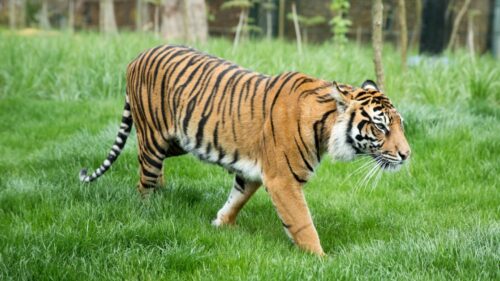
Sumatran tiger
Ecotourism and Green Life in Batu Katak
Most inhabitants of Batu Katak live from smallholder farming and fishing, while some residents relied solely on monoculture agriculture such as rubber and palm oil. As a source of livelihood diversification some inhabitants of Batu Katak started to develop tourism around 2010. Besides international tourists, domestic tourism plays an important role. Most of the activities such as trekking, rafting, or caving are usually done by international tourists while domestic tourists tend to be more interested in daytrips, picnics, and photoshoots at charming natural scenes (e.g., at a waterfall). This makes international tourists more profitable.
Adjacent to Batu Katak an important conservation and ecotourism initiative, Green Life, developed since 2009 on privatized land. A Czech and an Indonesian NGO are the new owners and managers of the land. Green Life buys the land from local landowners, claiming to give them a very good price for land of little value. As such, Green Life presents a clear case of “green grabbing”, which is “the appropriation of land and resources for environmental ends” (Fairhead, Leach, and Scoones 2012, 238). The project aims to prevent large-scale deforestation by the oil palm and paper industry, and to curb “the illegal encroachment of poachers, loggers and plantations”.[1] Currently, Green Life consists of 107.3 hectares and there is the ambition to grow to 700 hectares.
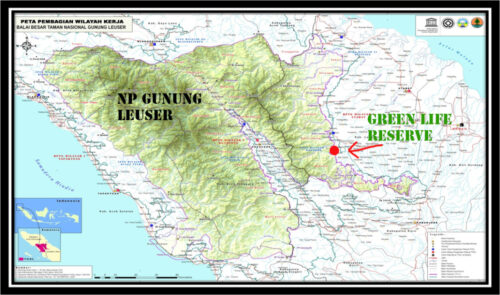
The location of Green Life[2]
In Green Life’s perception humans and nature, especially wildlife, can no longer peacefully co-exist and thus nature needs to be separated from “the greedy, spiteful, stupid, or characterless people who, around us, commit crimes against nature”.[3] Various Green Life employees and enthusiasts considered people living around MLNP as the biggest threat to nature, especially poachers from the neighbouring villages who “haven’t been confronted yet”.[4] To prevent illegal practices, they have set up the ‘Tiger Commando’, an anti-poaching unit and they have started to use camera traps, put up posters and sign boards that list all forbidden activities inside MLNP and on their reserves.
Initially, Green Life barely engaged with the local community. This changed when the project tried to obtain a license to extend the range of the Tiger Commando and to gain authority to patrol against illegal activities inside MLNP. To receive this license, the Indonesian government requested Green Life to involve the surrounding communities. To establish a good relationship with local inhabitants, connect to global audiences, and to raise funds, a crucial activity is ecotourism, which is presented by Green Life as an income-generating opportunity through guided tours, to ensure that “local people protect nature because it has become valuable to them” (fieldnotes, 13 January, 2018). Volunteer ecotourists generate a steady source of income for the project and they support the inhabitants of Batu Katak by creating employment.
Since its arrival, Green Life has been buying up small-scale rubber and oil palm plantations on the border of MLNP, increasingly reducing agricultural opportunities. Although Green Life states that the inhabitants from Batu Katak can buy land that is located closer to the village, inhabitants claim that there is no land available there, or that the price of land has risen since the arrival of Green Life. Furthermore, according to Green Life ‘poaching’ also includes fishing, which is officially forbidden inside MLNP and no longer allowed by Green Life in or close to its reserves either. Yet, many inhabitants from Batu Katak are at least partly dependent on fishing. Access to the rivers has become a sensitive matter between Green Life and the community.
The volunteers are a source of revenue for Green Life; they help to maintain the camps and reserves, and shy away poachers by their presence in the forest. Although volunteers can also go on excursions with local guides from Batu Katak, people working in tourism do so mostly for Green Life’s volunteers, as tour guides, porters of food, as assistants to do shopping, or as drivers to the airport in Medan. New forms of (irregular) employment have thus emerged from Green Life’s volunteer programme, diversifying livelihood strategies. Working as a tour guide for one day can earn someone a wage that sometimes equals a week’s work on a rubber plantation and is therefore a popular job, but the downside is that these are not a very stable type of employment because they are irregular, and some inhabitants have been able to gain more benefits out of the project than others, thus changing socio-economic structures.
Green Life and its employees have experienced violence and threats in the past. These included anonymous phone calls, threats to burn down Green Life’s camps and the damaging and stealing of camera traps and signposts. Such responses by the community obviously undermine Green Life’s conservation practices and goals and are interpreted by the Green Life management as evidence that local communities do not know (yet) how to live with, or protect, nature and are just interested in money. However, the valuation of land and nature by the local community seems to be more complex and is not necessarily valued in terms of money only, but also in terms of livelihoods and intrinsic value. From such a perspective, establishing a nature reserve to which the local community does not have access might therefore seem illogical and wasteful to the local community itself. One manager acknowledged: “You need to be friendly with the locals and cooperate with the government. You cannot be too strict, or they won’t like you” (interview, 7 February 2018). He therefore tries to support the village and wants to establish good relationships with its inhabitants, but another manager explained not to be interested in people, but only in saving nature. Arguably, in its current form, ecotourism at Green Life is unlikely to establish the intended sustainable relations with the community, necessary for long-term conservation success. The main reason is that the strategy of privatisation comes with too many downsides for the villagers of Batu Katak.

Entrance sign to Mount Leuser National Park
COVID-19 has also had a significant impact on the livelihoods of people in Batu Katak. Subsequent travel restrictions have had a dramatic impact on tourism, the largest economic industry in the world. The ongoing COVID-19 pandemic highlights the limits of ecotourism to preserve biodiversity and empower people. Whereas ecotourism is often presented as an important livelihood diversification strategy to increase people’s social sustainability, a shock/stress like the COVID-19 pandemic shows that it is important to keep approaching ecotourism as a diversification strategy, and not let it grow too dominant. However, due to various attractive benefits, ecotourism often tends to prevail as a livelihood strategy, increasing dependency for marginalized groups, as was disclosed in Batu Katak and its surroundings after the onset of COVID-19.
Elephant-based ecotourism in Tangkahan
About 60 kilometres to the North, in Tangkahan, the commodification of nature and not privatisation plays a dominant role: here ecotourism revolves around encounters between elephant handlers (mahouts) and captive elephants and between tourists and elephants. Most of the men living there used to work as illegal loggers and allegedly caused forest destruction; today, they earn a living through ecotourism, working in guest houses and on food stalls, selling souvenirs, and acting as tour guides. Elephant-based activities—consisting of elephant bathing, elephant grazing, and trekking (where the people walk alongside the elephants)—have become the main tourist attractions.
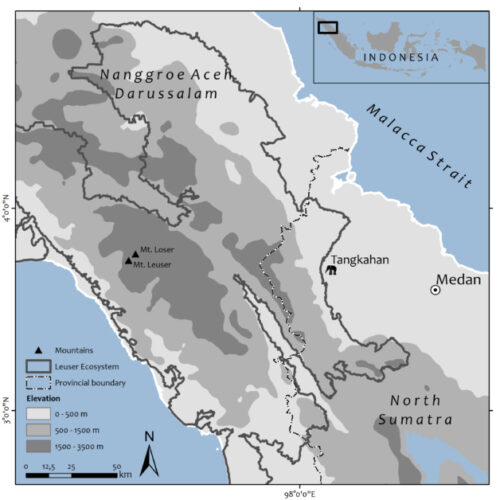
Tangkahan
The captive elephants in Tangkahan are managed by the Conservation Response Unit (CRU), based on an agreement with MLNP. The CRU program makes a clear distinction between ‘captive’ and ‘conflict’ elephants. Conflict elephants refers to wild elephants that were involved in human-elephant conflicts. With the conversion of their habitat into agricultural plots and plantations, elephants have increasingly engaged in crop-raiding to feed themselves. With growing human encroachment around elephant habitats, encounters between elephants and humans have often taken the form of conflicts. Captive elephants are either former conflict elephants that have been captured, tamed, and trained or else the offspring of such elephants born in captivity. At the time of fieldwork in 2018/19, there were nine captive elephants in Tangkahan: six adults and three calves, of which the adult elephants were all former conflict elephants and the calves born in captivity.
Trained to sell encounters with tourists, the elephants of Tangkahan are ‘lively commodities’ in captivity: they must remain alive to gain value as a commodity. The commodity value of lively commodities “is derived from their status as living beings” (Collard and Dempsey 2013, 2648, emphasis in original). Also in Tangkahan, no value is produced when the commodity somehow ceases to live, whatever the cause of death (killing, disease, old age, etc.). Commodities derived from living beings that are no longer alive, such as meat, are not lively commodities; it is the status as ‘alive’ that is crucial, together with reproductive capacity. However, it is not simply the status of being alive that produces value. In Tangkahan ecotourism, it is the human encounter with the living animal that is the commodity. This inter-species ‘encounter value’ occurs among “subjects of different biological species” forming relationships (Haraway 2008, 46). Commodification thus takes place in the encounter. This way, captive elephants take on capitalist value in ecotourism: value is exploited through moments interactions between captive elephants, mahouts, and tourists. In this case, what is sold as a commodity is not the animal as such, but an experience of/with it, the experience of having an encounter with the encounterable animals. Thus, the animals are made to produce multispecies encounters through which experience is generated. Pivotal in this process is the division between conflict and captive elephants: only captive elephants can perform activities that make them lively commodities in an ecotourism reality. The incorporation of captive elephants is thus a crucial moment in their transformation into commodities as valuable lively beings in ecotourism activities, which is where their monetary value culminates. This way they become financially productive animals.
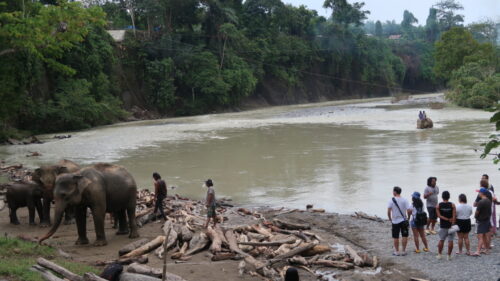
A typical scene in Tangkahan
An important job for the mahouts is to bathe the elephants by commanding them to enter the river and let them bathe there. They are brushed in the water, and to enable tourists to participate, the elephants have been trained to lie down at the riverbed so that the visitors can brush the elephants’ bodies comfortably. Elephants are also trained to deliver a performance that affords the encounter increased value by, among other things, spraying water with their trunk over their own back (which removes the sand and mud) and thus washing in the river. To provide a good photographic moment, they face the tourists when they do this, and at the end of the bathing session, tourists take pictures of the elephants and mahouts, who sit on top of each elephant. For this, they have also been trained to show the trunk affront, facing the tourists in the most photogenic pose. The encounter is a scripted performance: the elephant riverbank washing performance, for instance, is staged next to the rainforest. From the gathering point where tourists wait for the elephants to come out of the trees, the density of the rainforest ensures an awe-inspiring setting: thousands of high, towering trees are filled with the sounds of monkeys, birds, and a large variety of other animals. Tourists can easily catch sight of these creatures running, jumping, and flying around. Then, when the elephants come out from the forests on the far side of the river, they enter and cross over. This is when tourists normally start to take pictures and make videos of the elephants with the forest in the background. It is this carefully orchestrated, ‘authentic’ spectacle that provides the encounter and thus the creation of value.
In this line, an introductory talk is given to the tourists, explaining the history of captive elephants. This is important to clarify that elephant-based ecotourism as performed in Tangkahan is not about the erasure of the animals from their natural habitat but about looking after the elephants that were previously involved in conflicts. In the ecotourism narrative, the care for conflict elephants is clearly articulated to distinguish it from the previous program, in which capturing and taming wild elephants was portrayed as brutal. The aim is to provide tourists with a sense of contributing to elephant care and conservation efforts. Directly and indirectly, the ecotourism performance aims to incorporate tourists into a narrative of non-exploitative conservation activities, with ecotourism articulated as saving and caring for former conflict elephants. Yet, selling encounters with captive elephants helps to keep them in captivity, under the direct control and care by humans in a human-made enclosure. Ecotourism thus constitutes a transformative activity through which lively commodities generate value and in which this type of value production also produces and maintains captive nature.
Conclusion
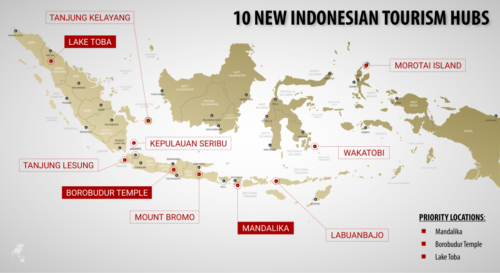
‘10 New Bali’s’, including Lake Toba[5]
Small, remote tourism places such as Batu Katak and Tangkahan are often visited by tourists on the same itinerary, which in Sumatra also includes the mass tourism destinations Bukit Lawang (that revolves around orangutan encounters) and Lake Toba, the latter of which is located around 180-200 kilometres away. Lake Toba has been identified by the Indonesian government as one of three ‘priority locations’ out of “10 new Balis” that they have identified to stimulate further tourism growth. This growth was well on the way, including in North Sumatra, but is currently disrupted by COVID-19. Due to its proximity, MLNP is likely to be affected by the growth plans for Lake Toba, and it remains to be seen how local groups living in the buffer zones of MLNP will respond to this growth of (eco)tourism, providing for the expansion of capitalist values such as privatisation and commodification. As we have shown in this blog, privatization has serious consequences for local communities, while the commodification of nature is a questionable conservation strategy. Currently at Lake Toba, tourism growth has already led to a legal battle with indigenous peoples who have been evicted for the establishment of luxurious tourism resorts, while farms and plots have been destroyed for this.[6] This does not necessarily mean that this will also happen at MLNP, but privatisation as green grabbing and the commodification of nature are questionable strategies that expand capitalist values to the remotest rural places.
References
Buiskool, Roderick, and Stasja Koot. forthcoming. “COVID-19 and the limits of community-based ecotourism as a sustainable livelihood diversification strategy: The case of the indigenous Karo of Batu Katak, North Sumatra, Indonesia.” In Ecotourism impacts on indigenous peoples, edited by Wayne Babchuck and Robert Hitchcock. Lexington Books.
Collard, Rosemary-Claire, and Jessica Dempsey. 2013. “Life for sale? The politics of lively commodities.” Environment and Planning A: Economy and Space 45 (11):2682-99. doi: https://doi.org/10.1068/a45692
Duffy, Rosaleen. 2013. “The international political economy of tourism and the neoliberalisation of nature: Challenges posed by selling close interactions with animals.” Review of International Political Economy 20 (3):605-26. https://doi.org/10.1080/09692290.2012.654443
Fairhead, J., M. Leach, and I. Scoones. 2012. “Green Grabbing: A new appropriation of nature?” Journal of Peasant Studies 39 (2):237-61. doi: https://doi.org/10.1080/03066150.2012.671770
Haraway, Donna. 2008. When species meet. London: University of Minnesota Press.
Ni’am, Lubabun, Stasja Koot, and Joost Jongerden. 2021. “Selling captive nature: Lively commodification, elephant encounters, and the production of value in Sumatran ecotourism, Indonesia.” Geoforum 127:162-70. doi: https://doi.org/10.1016/j.geoforum.2021.10.018
Wieckardt, Chantal, Stasja Koot, and Nadya Karimasari. 2020. “Environmentality, green grabbing, and neoliberal conservation: The ambiguous role of ecotourism in the Green Life privatised nature reserve, Sumatra, Indonesia.” Journal of Sustainable Tourism. doi: https://doi.org/10.1080/09669582.2020.1834564
[1] http://greenlifeproject.org/green-life-reserve-2/, accessed 10 November 2021.
[2] Source: http://greenlifeproject.org/green-life-reserve-2/, accessed 14 November 2021
[3] http://greenlifeproject.org/forest-for-children/, accessed 10 November 2021.
[4] http://greenlifeproject.org/threats/, accessed 10 November 2021.
[5] Source: https://invest-islands.com/ten-new-bali-project/, accessed 12 November 2021.
[6] https://news.mongabay.com/2021/10/indigenous-group-faces-eviction-for-new-bali-tourism-project-in-sumatra/?mc_cid=708f531259&mc_eid=f96fa23af1, accessed 12 November 2021.
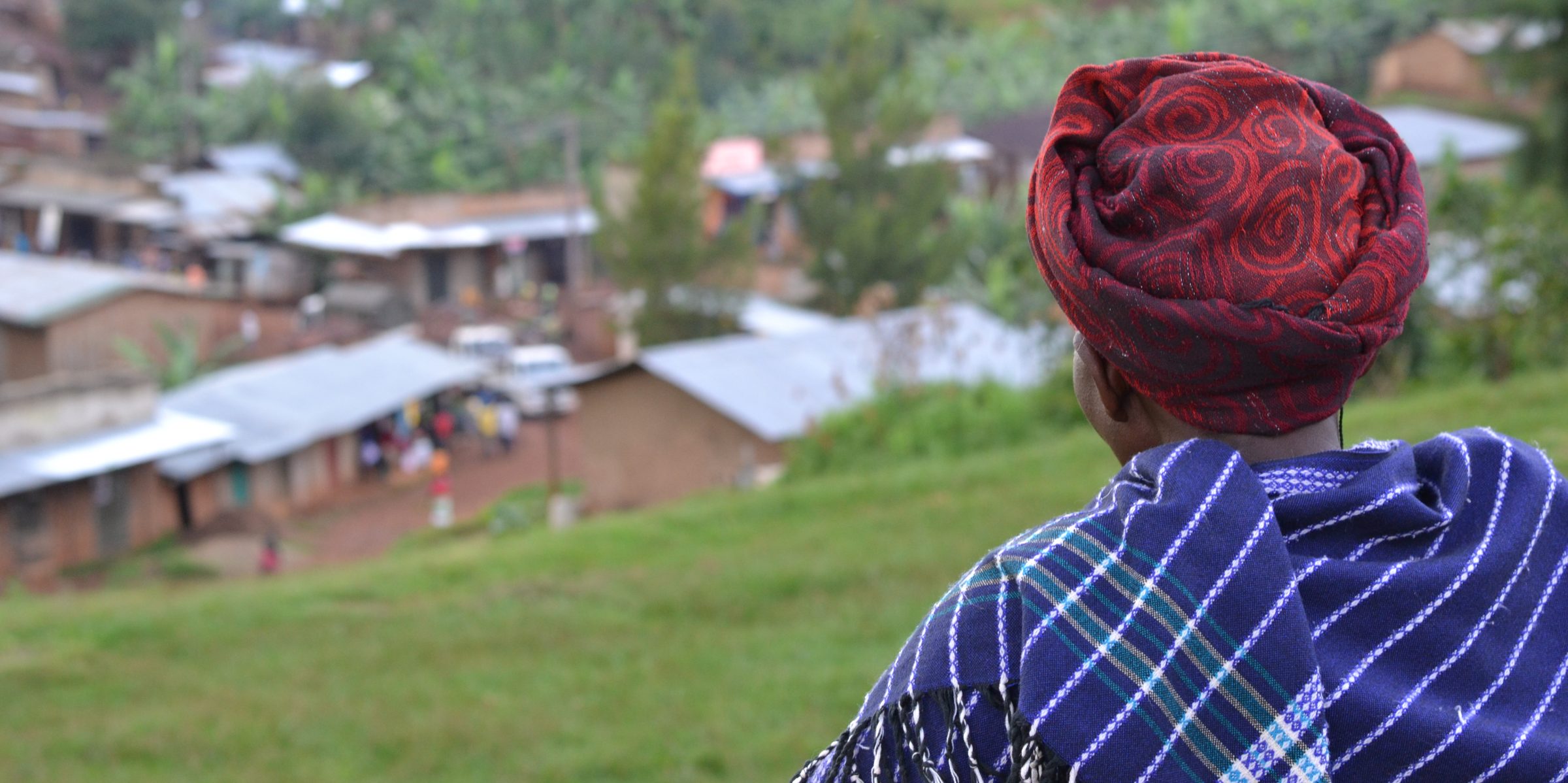
Posted: 16th December 2021 by Coordinator
Blog | Privatisation and commodification: Ecotourism as capitalist expansion in Sumatra, Indonesia
Privatisation and commodification: Ecotourism as capitalist expansion in Sumatra, Indonesia
By Stasja Koot, Lubabun Ni’am, Chantal Wieckardt, Roderick Buiskool, Nadya Karimasari, Joost Jongerden
Introduction
In this blog post, we explore recent ecotourism developments as capitalist expansion in the buffer zone to the east of the Mount Leuser National Park (MLNP), Sumatra, Indonesia. The close interaction with nature, and some specific charismatic animals, provide for spreading neoliberal values through tourism to otherwise remote places (Duffy 2013), including important processes of privatisation and commodification. We first elaborate on privatisation. Specific attention is paid to the Green Life volunteer ecotourism project in Batu Katak and its role in ‘green grabbing’ for conservation. Second, we focus on commodification and how value is created through human interactions with captive elephants in Tangkahan. The blog ends with a short conclusion on the development of tourism growth more broadly and its potential effects for nature and people. The blog is based on two recently published papers (Ni’am, Koot, and Jongerden 2021; Wieckardt, Koot, and Karimasari 2020) and one forthcoming book chapter (Buiskool and Koot forthcoming). Research for these publications was carried out between February 2017 and April 2020.
Batu Katak and Tangkahan are both situated adjacent to MLNP, which is the main biodiversity hotspot of Sumatra, consisting of tropical forest. Indonesia has one of the highest rates of deforestation, and Sumatra stands out in this regard. Most people living in the vicinity of MLNP are dependent on the forests for their sustenance and livelihoods, making the conservation of the rainforest highly important for the local population. Tourists are attracted to MLNP because of its endemic flora, including the biggest flowers in the world, and endangered fauna such as the Sumatran orangutan, the black-furred gibbon, the Malayan sun bear, the Sumatran tiger, the Sumatran rhinoceros and the Sumatran elephant. Ecotourism activities include jungle trekking, wildlife spotting, caving, bird watching, camping, cultural activities and wild water rafting.
Sumatran tiger
Ecotourism and Green Life in Batu Katak
Most inhabitants of Batu Katak live from smallholder farming and fishing, while some residents relied solely on monoculture agriculture such as rubber and palm oil. As a source of livelihood diversification some inhabitants of Batu Katak started to develop tourism around 2010. Besides international tourists, domestic tourism plays an important role. Most of the activities such as trekking, rafting, or caving are usually done by international tourists while domestic tourists tend to be more interested in daytrips, picnics, and photoshoots at charming natural scenes (e.g., at a waterfall). This makes international tourists more profitable.
Adjacent to Batu Katak an important conservation and ecotourism initiative, Green Life, developed since 2009 on privatized land. A Czech and an Indonesian NGO are the new owners and managers of the land. Green Life buys the land from local landowners, claiming to give them a very good price for land of little value. As such, Green Life presents a clear case of “green grabbing”, which is “the appropriation of land and resources for environmental ends” (Fairhead, Leach, and Scoones 2012, 238). The project aims to prevent large-scale deforestation by the oil palm and paper industry, and to curb “the illegal encroachment of poachers, loggers and plantations”.[1] Currently, Green Life consists of 107.3 hectares and there is the ambition to grow to 700 hectares.
The location of Green Life[2]
In Green Life’s perception humans and nature, especially wildlife, can no longer peacefully co-exist and thus nature needs to be separated from “the greedy, spiteful, stupid, or characterless people who, around us, commit crimes against nature”.[3] Various Green Life employees and enthusiasts considered people living around MLNP as the biggest threat to nature, especially poachers from the neighbouring villages who “haven’t been confronted yet”.[4] To prevent illegal practices, they have set up the ‘Tiger Commando’, an anti-poaching unit and they have started to use camera traps, put up posters and sign boards that list all forbidden activities inside MLNP and on their reserves.
Initially, Green Life barely engaged with the local community. This changed when the project tried to obtain a license to extend the range of the Tiger Commando and to gain authority to patrol against illegal activities inside MLNP. To receive this license, the Indonesian government requested Green Life to involve the surrounding communities. To establish a good relationship with local inhabitants, connect to global audiences, and to raise funds, a crucial activity is ecotourism, which is presented by Green Life as an income-generating opportunity through guided tours, to ensure that “local people protect nature because it has become valuable to them” (fieldnotes, 13 January, 2018). Volunteer ecotourists generate a steady source of income for the project and they support the inhabitants of Batu Katak by creating employment.
Since its arrival, Green Life has been buying up small-scale rubber and oil palm plantations on the border of MLNP, increasingly reducing agricultural opportunities. Although Green Life states that the inhabitants from Batu Katak can buy land that is located closer to the village, inhabitants claim that there is no land available there, or that the price of land has risen since the arrival of Green Life. Furthermore, according to Green Life ‘poaching’ also includes fishing, which is officially forbidden inside MLNP and no longer allowed by Green Life in or close to its reserves either. Yet, many inhabitants from Batu Katak are at least partly dependent on fishing. Access to the rivers has become a sensitive matter between Green Life and the community.
The volunteers are a source of revenue for Green Life; they help to maintain the camps and reserves, and shy away poachers by their presence in the forest. Although volunteers can also go on excursions with local guides from Batu Katak, people working in tourism do so mostly for Green Life’s volunteers, as tour guides, porters of food, as assistants to do shopping, or as drivers to the airport in Medan. New forms of (irregular) employment have thus emerged from Green Life’s volunteer programme, diversifying livelihood strategies. Working as a tour guide for one day can earn someone a wage that sometimes equals a week’s work on a rubber plantation and is therefore a popular job, but the downside is that these are not a very stable type of employment because they are irregular, and some inhabitants have been able to gain more benefits out of the project than others, thus changing socio-economic structures.
Green Life and its employees have experienced violence and threats in the past. These included anonymous phone calls, threats to burn down Green Life’s camps and the damaging and stealing of camera traps and signposts. Such responses by the community obviously undermine Green Life’s conservation practices and goals and are interpreted by the Green Life management as evidence that local communities do not know (yet) how to live with, or protect, nature and are just interested in money. However, the valuation of land and nature by the local community seems to be more complex and is not necessarily valued in terms of money only, but also in terms of livelihoods and intrinsic value. From such a perspective, establishing a nature reserve to which the local community does not have access might therefore seem illogical and wasteful to the local community itself. One manager acknowledged: “You need to be friendly with the locals and cooperate with the government. You cannot be too strict, or they won’t like you” (interview, 7 February 2018). He therefore tries to support the village and wants to establish good relationships with its inhabitants, but another manager explained not to be interested in people, but only in saving nature. Arguably, in its current form, ecotourism at Green Life is unlikely to establish the intended sustainable relations with the community, necessary for long-term conservation success. The main reason is that the strategy of privatisation comes with too many downsides for the villagers of Batu Katak.
Entrance sign to Mount Leuser National Park
COVID-19 has also had a significant impact on the livelihoods of people in Batu Katak. Subsequent travel restrictions have had a dramatic impact on tourism, the largest economic industry in the world. The ongoing COVID-19 pandemic highlights the limits of ecotourism to preserve biodiversity and empower people. Whereas ecotourism is often presented as an important livelihood diversification strategy to increase people’s social sustainability, a shock/stress like the COVID-19 pandemic shows that it is important to keep approaching ecotourism as a diversification strategy, and not let it grow too dominant. However, due to various attractive benefits, ecotourism often tends to prevail as a livelihood strategy, increasing dependency for marginalized groups, as was disclosed in Batu Katak and its surroundings after the onset of COVID-19.
Elephant-based ecotourism in Tangkahan
About 60 kilometres to the North, in Tangkahan, the commodification of nature and not privatisation plays a dominant role: here ecotourism revolves around encounters between elephant handlers (mahouts) and captive elephants and between tourists and elephants. Most of the men living there used to work as illegal loggers and allegedly caused forest destruction; today, they earn a living through ecotourism, working in guest houses and on food stalls, selling souvenirs, and acting as tour guides. Elephant-based activities—consisting of elephant bathing, elephant grazing, and trekking (where the people walk alongside the elephants)—have become the main tourist attractions.
Tangkahan
The captive elephants in Tangkahan are managed by the Conservation Response Unit (CRU), based on an agreement with MLNP. The CRU program makes a clear distinction between ‘captive’ and ‘conflict’ elephants. Conflict elephants refers to wild elephants that were involved in human-elephant conflicts. With the conversion of their habitat into agricultural plots and plantations, elephants have increasingly engaged in crop-raiding to feed themselves. With growing human encroachment around elephant habitats, encounters between elephants and humans have often taken the form of conflicts. Captive elephants are either former conflict elephants that have been captured, tamed, and trained or else the offspring of such elephants born in captivity. At the time of fieldwork in 2018/19, there were nine captive elephants in Tangkahan: six adults and three calves, of which the adult elephants were all former conflict elephants and the calves born in captivity.
Trained to sell encounters with tourists, the elephants of Tangkahan are ‘lively commodities’ in captivity: they must remain alive to gain value as a commodity. The commodity value of lively commodities “is derived from their status as living beings” (Collard and Dempsey 2013, 2648, emphasis in original). Also in Tangkahan, no value is produced when the commodity somehow ceases to live, whatever the cause of death (killing, disease, old age, etc.). Commodities derived from living beings that are no longer alive, such as meat, are not lively commodities; it is the status as ‘alive’ that is crucial, together with reproductive capacity. However, it is not simply the status of being alive that produces value. In Tangkahan ecotourism, it is the human encounter with the living animal that is the commodity. This inter-species ‘encounter value’ occurs among “subjects of different biological species” forming relationships (Haraway 2008, 46). Commodification thus takes place in the encounter. This way, captive elephants take on capitalist value in ecotourism: value is exploited through moments interactions between captive elephants, mahouts, and tourists. In this case, what is sold as a commodity is not the animal as such, but an experience of/with it, the experience of having an encounter with the encounterable animals. Thus, the animals are made to produce multispecies encounters through which experience is generated. Pivotal in this process is the division between conflict and captive elephants: only captive elephants can perform activities that make them lively commodities in an ecotourism reality. The incorporation of captive elephants is thus a crucial moment in their transformation into commodities as valuable lively beings in ecotourism activities, which is where their monetary value culminates. This way they become financially productive animals.
A typical scene in Tangkahan
An important job for the mahouts is to bathe the elephants by commanding them to enter the river and let them bathe there. They are brushed in the water, and to enable tourists to participate, the elephants have been trained to lie down at the riverbed so that the visitors can brush the elephants’ bodies comfortably. Elephants are also trained to deliver a performance that affords the encounter increased value by, among other things, spraying water with their trunk over their own back (which removes the sand and mud) and thus washing in the river. To provide a good photographic moment, they face the tourists when they do this, and at the end of the bathing session, tourists take pictures of the elephants and mahouts, who sit on top of each elephant. For this, they have also been trained to show the trunk affront, facing the tourists in the most photogenic pose. The encounter is a scripted performance: the elephant riverbank washing performance, for instance, is staged next to the rainforest. From the gathering point where tourists wait for the elephants to come out of the trees, the density of the rainforest ensures an awe-inspiring setting: thousands of high, towering trees are filled with the sounds of monkeys, birds, and a large variety of other animals. Tourists can easily catch sight of these creatures running, jumping, and flying around. Then, when the elephants come out from the forests on the far side of the river, they enter and cross over. This is when tourists normally start to take pictures and make videos of the elephants with the forest in the background. It is this carefully orchestrated, ‘authentic’ spectacle that provides the encounter and thus the creation of value.
In this line, an introductory talk is given to the tourists, explaining the history of captive elephants. This is important to clarify that elephant-based ecotourism as performed in Tangkahan is not about the erasure of the animals from their natural habitat but about looking after the elephants that were previously involved in conflicts. In the ecotourism narrative, the care for conflict elephants is clearly articulated to distinguish it from the previous program, in which capturing and taming wild elephants was portrayed as brutal. The aim is to provide tourists with a sense of contributing to elephant care and conservation efforts. Directly and indirectly, the ecotourism performance aims to incorporate tourists into a narrative of non-exploitative conservation activities, with ecotourism articulated as saving and caring for former conflict elephants. Yet, selling encounters with captive elephants helps to keep them in captivity, under the direct control and care by humans in a human-made enclosure. Ecotourism thus constitutes a transformative activity through which lively commodities generate value and in which this type of value production also produces and maintains captive nature.
Conclusion

‘10 New Bali’s’, including Lake Toba[5]
Small, remote tourism places such as Batu Katak and Tangkahan are often visited by tourists on the same itinerary, which in Sumatra also includes the mass tourism destinations Bukit Lawang (that revolves around orangutan encounters) and Lake Toba, the latter of which is located around 180-200 kilometres away. Lake Toba has been identified by the Indonesian government as one of three ‘priority locations’ out of “10 new Balis” that they have identified to stimulate further tourism growth. This growth was well on the way, including in North Sumatra, but is currently disrupted by COVID-19. Due to its proximity, MLNP is likely to be affected by the growth plans for Lake Toba, and it remains to be seen how local groups living in the buffer zones of MLNP will respond to this growth of (eco)tourism, providing for the expansion of capitalist values such as privatisation and commodification. As we have shown in this blog, privatization has serious consequences for local communities, while the commodification of nature is a questionable conservation strategy. Currently at Lake Toba, tourism growth has already led to a legal battle with indigenous peoples who have been evicted for the establishment of luxurious tourism resorts, while farms and plots have been destroyed for this.[6] This does not necessarily mean that this will also happen at MLNP, but privatisation as green grabbing and the commodification of nature are questionable strategies that expand capitalist values to the remotest rural places.
References
Buiskool, Roderick, and Stasja Koot. forthcoming. “COVID-19 and the limits of community-based ecotourism as a sustainable livelihood diversification strategy: The case of the indigenous Karo of Batu Katak, North Sumatra, Indonesia.” In Ecotourism impacts on indigenous peoples, edited by Wayne Babchuck and Robert Hitchcock. Lexington Books.
Collard, Rosemary-Claire, and Jessica Dempsey. 2013. “Life for sale? The politics of lively commodities.” Environment and Planning A: Economy and Space 45 (11):2682-99. doi: https://doi.org/10.1068/a45692
Duffy, Rosaleen. 2013. “The international political economy of tourism and the neoliberalisation of nature: Challenges posed by selling close interactions with animals.” Review of International Political Economy 20 (3):605-26. https://doi.org/10.1080/09692290.2012.654443
Fairhead, J., M. Leach, and I. Scoones. 2012. “Green Grabbing: A new appropriation of nature?” Journal of Peasant Studies 39 (2):237-61. doi: https://doi.org/10.1080/03066150.2012.671770
Haraway, Donna. 2008. When species meet. London: University of Minnesota Press.
Ni’am, Lubabun, Stasja Koot, and Joost Jongerden. 2021. “Selling captive nature: Lively commodification, elephant encounters, and the production of value in Sumatran ecotourism, Indonesia.” Geoforum 127:162-70. doi: https://doi.org/10.1016/j.geoforum.2021.10.018
Wieckardt, Chantal, Stasja Koot, and Nadya Karimasari. 2020. “Environmentality, green grabbing, and neoliberal conservation: The ambiguous role of ecotourism in the Green Life privatised nature reserve, Sumatra, Indonesia.” Journal of Sustainable Tourism. doi: https://doi.org/10.1080/09669582.2020.1834564
[1] http://greenlifeproject.org/green-life-reserve-2/, accessed 10 November 2021.
[2] Source: http://greenlifeproject.org/green-life-reserve-2/, accessed 14 November 2021
[3] http://greenlifeproject.org/forest-for-children/, accessed 10 November 2021.
[4] http://greenlifeproject.org/threats/, accessed 10 November 2021.
[5] Source: https://invest-islands.com/ten-new-bali-project/, accessed 12 November 2021.
[6] https://news.mongabay.com/2021/10/indigenous-group-faces-eviction-for-new-bali-tourism-project-in-sumatra/?mc_cid=708f531259&mc_eid=f96fa23af1, accessed 12 November 2021.
Category: News